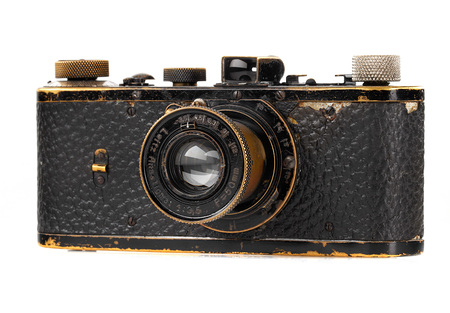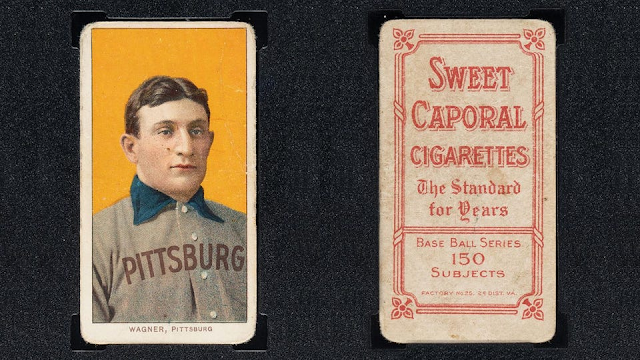By
Everyone else is making money from Leica Number 105 so I figured I’d throw my hat in the ring for a few bucks too.
Don’t know what I’m talking about? Last week, it was announced that Leica camera creator, Oskar Barnack’s personal 1923 prototype camera sold at auction for more than 20% over estimates, cashing out at a heart stopping 14.4 million Euro or over 15 million USD.
When it was initially announced that this rudimentary yet priceless camera would go to auction, many news sources and influencers set out to describe the camera’s known history and provide some context and commentary.
However, nobody seemed to be prepared for this auction to so completely, and grossly, obliterate any previous camera sales record by such an incredible margin.
The last most expensive camera to sell at auction, was also a 1923 Leica 0-Series, Number 122. It sold in 2018 for 2.4 million Euro.
Given the rise of lavish and seemingly ludicrous spending during COVID market volatility such as Kurt Cobain’s Fender Mustang guitar for $4.5 million in May, a Honus Wagner baseball card for $6.6 million in 2021 and May Ray’s Le Violon d’Ingres for $12.4 million, also in May 2022, I actually wonder why the initial estimates for Leica Number 105 were so low. The highest estimate I found was a “mere” 3.5 million Euro.
So here’s what makes Number 105 more than just another dusty old Leica.
Number 105 was Oskar Barnack’s personal camera. He used it to both test and refine the Leica design but also just to enjoy for the camera’s original purpose; one that was small and light enough to carry casually in order to document ordinary situations, yet to produce high quality images of scenes that would otherwise exist only in memory.
Just like a tatty, budget guitar, an old photo that someone drew on, or a soiled trading card, by all but metaphysical accounts, this basic brassed camera can be seen as pretty worthless. It contains no focusing mechanism, the original black enamel finish is well-worn, vulcanite is coming off in spots, it’s puny viewfinder is dirty and Number 105 even features something that usually devalues vintage cameras – the original owner’s name is inscribed on it. But perhaps like all true collectibles, Leica Number 105 is so beloved today because it wasn’t set out to be anything more than it was.
Apparently Leica Number 105 is still in 100% working order. On such a simple camera, all this really means is that it does not leak light, it advances film accordingly, the frame counter counts and the small compliment of shutter speeds are accurate enough for print film. So maybe it’s intrinsic value is not a total loss if you graduated the Fred Flintstone School of Street Photography.
15 million bucks, for any camera, working or not, historically relevant or not is perhaps merely an illustration of an appallingly widening wealth gap; an example of bold-faced money laundering; capitalist culture’s obsession with superficial objects; and an on-going, world-wide confusion between the terms “invaluable” and “valueless.”
Yes, this is one of only about 23 Leica 0-Series cameras that launched the concept of stream-of-consciousness photography. And yes, it was owned by the guy who came up with the watershed execution of that still sought after ideal. Leica Number 105 changed how we could take photos as well as how we viewed photography. But $15,000,000? You mean to tell me that peoples’ lives couldn’t somehow be improved on a massive scale with a more appropriate application of these kinds of funds? Proceeds from Kurt Cobain’s guitar sale went to mental health charities. What if we pumped $15 million into film production and floored the sharp rises in costs for film photographers? That might improve our mental health!
Another relevant question: Should such important cultural artifacts even be sold privately? Shouldn’t the rightful home of such things be in the careful curation of public museums? What gives collectors or investment groups, the right to privatize an international treasure? Doesn’t Leica Number 105 belong to all of us who have shared its vision? I’m sure that this line of questioning is older than Warren Buffett but after these kinds of sales, one must return to it.
I submit that, in order to understand the swelling monetization of unlikely objects like Leica Number 105, we must also appreciate their simple material nature that seems at odds with their pricing. These are just things. Often these things are acquired or rediscovered more or less by chance and demand no special investment or upkeep before their cultural value is illuminated. Which is precisely why their value comes as a sudden shock. Perhaps without having been temporarily ignored, Leica Number 105 would have slowly gained value with age and the achievements of the business. Would we still be talking about Number 105 if Oskar had simply left it at Wetzlar for display back in the 50’s? Would it have just gotten lost amongst the other ten 0-Series cameras if it hadn’t been inscribed and its ownership documented?
In addition to appreciating the underwhelming material nature of iconic objects of desire, we must also appreciate how situational their exchanges often are. The owner of Leica Camera 105 may easily be someone who was cleaning out the closet at a time in their life when money was needed. As outsiders peering at Leica Number 105 through security glass, we are free to imagine lofty ideals – wiser and more humane things to do with the money (if we had it), or the object itself (if we had it). However, just as camera is nothing more than a camera, people are nothing more than people. And we all have needs, hopes and dreams for ourselves and our families. You might not have $15 million to give, but you likely have some smaller amount. I’m sure that photographers reading this have resold their used equipment. While you probably didn’t net many millions in profit, likely, your needs and motivations were no different than those who owned this camera. Why didn’t you give the $100 or $200 proceeds from selling your dad’s Nikon to your favorite charity? Last year, I sold a couple cameras that weren’t being used to fund a new laptop for my daughter. Will those vintage cameras work longer and retain their value longer than the laptop? Probably, but she needed a laptop for school and I have too many cameras. My point is that everything’s relative. Yes, even when talking at this scale – at least so far as I understand. Does the scale of an action determine its ethics or lack thereof?
According to representatives from Leitz Photographica Auction, Leica Number 105 stayed with Oskar Barnack’s family until the 1960’s when Japanese SLR’s began to take over the German rangefinder market and the little camera was perhaps looking dated as opposed to historic. Number 105 was on display briefly before it was sold to a collector in the United States. Not long after Leica Number 105 departed the Barnack family, the Jacobs family purchased Man Ray’s Le Violon d’Ingres in 1962, Fender built a sub-$200 1969 Mustang guitar that Kurt Cobain would eventually buy and that Honus Wagner card was first sold in 1973 for $1,100.
Prior to its current-most sale this month, Leica Number 105 was again on display for public viewing in Leitz Park in Wetzlar, Germany where it was built in 1923. Both the last and latest owners’ identities do not appear to be publicly known at this time.
From this scant information, we can surmise that Barnack’s family long ago chose to sell the camera and that Leica were uninterested or unable to purchase the camera at that time, as well as at the 2022 auction. Given the company’s use of its own history to not only guide its marketing, but also new product design, it’s surprising that Leica itself did not acquire the camera. There is even a small camera museum at the Leica Factory where a 1914 UR Leica and another rare 1925 Leica Ia, among many other important cameras are on display. Number 105 would be the perfect addition here. And, whatever the cost, I don’t think people would be as offended by the purchase because it would presumably be available for public viewing. The purchase would simply make more sense.
My guess is that Leica preferred the accreditation that an auction to a third party buyer would bring to the camera. Thus adding tremendously more value to the Leica brand than simply buying back their own camera for posterity. “Hey, look, all these people determined how much our camera is worth! They said it, not us!” I would also guess that this is part of the strategy behind Leitz Photographica Auctions as a whole – expanding the Leica legend and justifying high pricing of Leica’s current products. This is just my personal speculation though.
We can also ponder about the first non-Barnack-family owners of Leica Number 105. I don’t believe that camera collecting was as common a pastime in the 1960’s as it is today. So we can only imagine that the first collector to purchase Number 105 was someone with an appreciation for modern history and industrial design moreso than a soulless investor as we imagine them today. He has likely passed away in the 60 years since acquiring the camera. Therefore, Number 105 was likely entered into the Leitz Photographica Auction by someone who inherited it from this “pure collector.” This narrative might rule out emotional connection of the last owner and can invite the possibility of the shear need or desire for the financial security of ones family as a motivation for the 2022 sale. A cynic might also point out that this could be the first point in the story where greed might have been a motivator. Millions of bucks for a relic that Dad or Grandad left laying in the closet? Sure, many would take this route over donating to a museum if it meant that we or our children could live that much more safely and comfortably.
This leads us to Leica Number 105’s new current owner. Is it an individual? Is it an investment group? Did they find the 15 million in the couch cushions or did they bet the farm to come up with this money? Will this information ever become public? And does it even matter? Would any information change our perceptions of this sale?
The way that I see it, Leica Number 105 served its original purpose beyond anyone’s expectations. It helped a photographer with asthma take snapshots of his family. It launched a revolution in photography that, today is so pervasive that its value goes without saying. Number 105 put (alot of) food on the table for Oskar Barnack and his family. And the family of the first collector to purchase it once it had been sold.
We can muse about the incomprehensible insanity of it’s recent sale all that we like but this is now merely another footnote in the quizzical, magical, mythical, gut-wrenching, face-palm-inducing history of this century-old hunk of aluminum, brass and glass.
Just like the Kurt Cobain Mustang, the Honus Wagner trading card and the Man Ray photo print, Leica Number 105 simply is what it is… and moreso.
Thanks for reading, happy shooting!
Follow, Favorite, Like, Add, Insult, Contact Johnny Martyr
For other articles on this blog please click on Blog Archive in the column to the right





















No comments:
Post a Comment